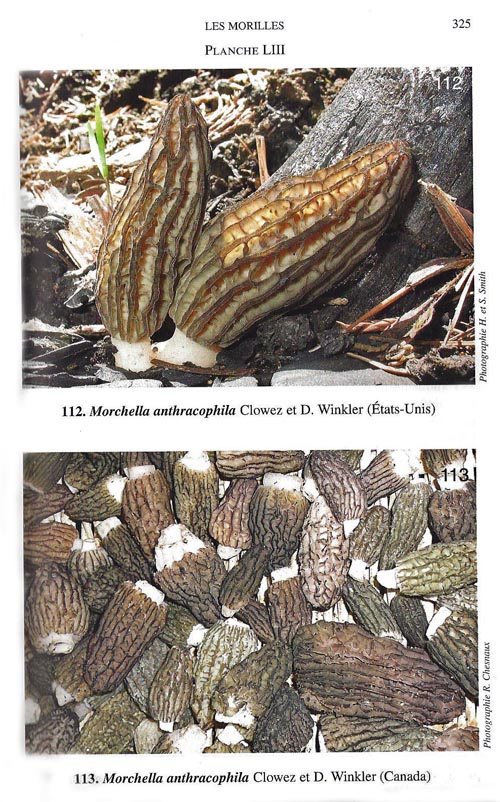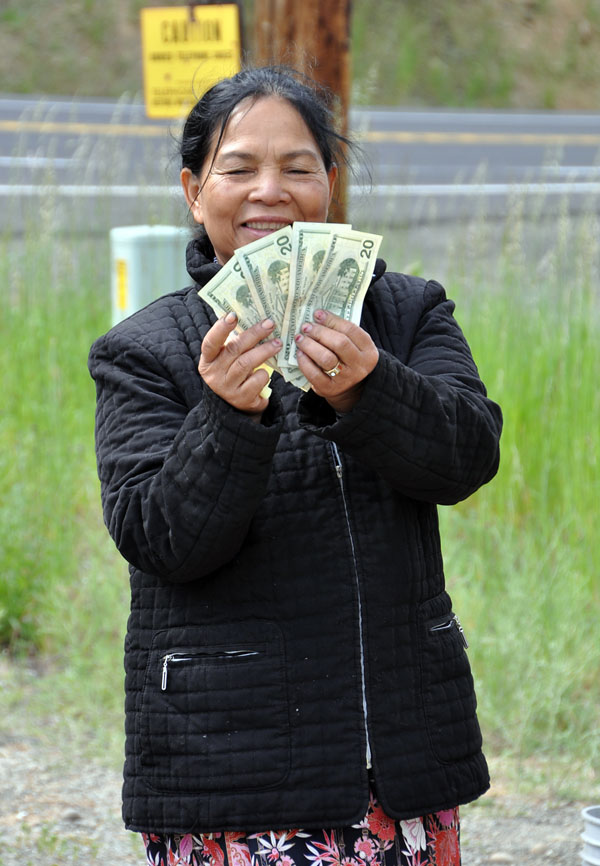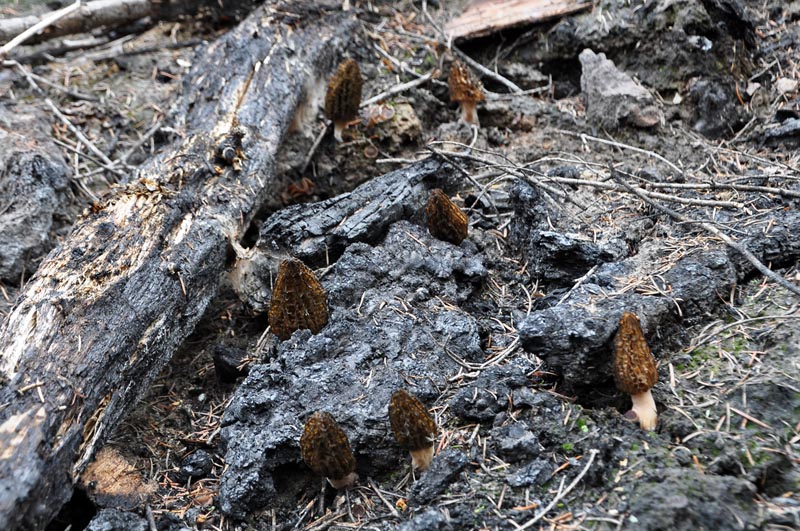
The late summer and early fall of 2012 was extremely dry and very sunny in the Pacific Northwest. This did not just cause a great tomato harvest and awesome days for swimming all August and September, but it also created perfect conditions for many forest fires on the Eastern slope of the Cascade Mountains in Washington State. Fires are an essential part of the ecosystem in these forests. Not surprisingly many members of the ecosystem have adapted to fire. Thick barks of Ponderosa pines that protect the tree from fire impact is a commonly known adaptation. Well known in the mushroomer community is the adaptation of several endemic morel species that have developed a special strategy in response to forest fires. Before white mens' fire suppression policies of the last 150 years, forest fires have burned much more frequently and thus less devastating. In other words, there used to be many more ground fires, and thus less stand-replacing crown fires. And fire morels will not fruit unless the soil gets charred above their mycelium and sclerotia, the latter a fungal tuber-like tissue that stores energy. Some how the burning triggers a fruiting reaction in these fire morels in the first spring or early summer after the fire event. There is normally only one season of incredible fire morel abundance, the second year thee is only a few tardy ones. However, if is a very dry year then the next year will have a the morel explosion.
Link to the Gourmet Fire Morel Foray info page
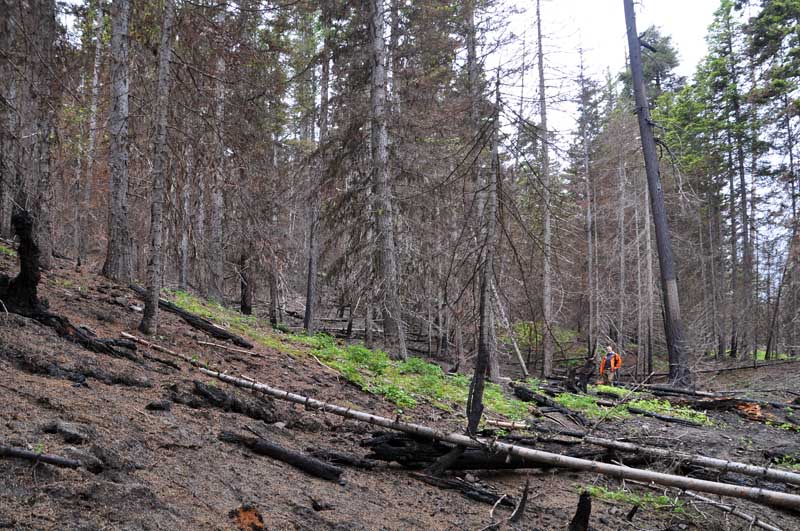
Here a typical scene on the west slope of Table Mountain. Note the mixture of burned ground and trees and vegetation that has not been killed by the the fire. It always puzzles me how so many spots do not get burned thinking of the intensity of the heat generated and the winds that develop around a fast moving fire.
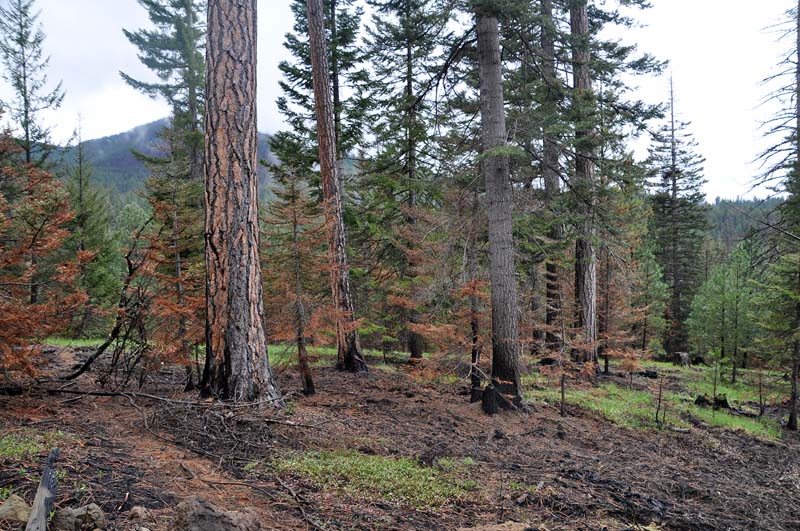
In many areas, especially more open areas, the fire burns lots of downed decaying logs and groups of young stands. Such a landscape is much better adapted to reoccurring fires than dense forests as propagated since fire suppression.
Fire morels are only found in charred areas, but "naturals" might grow in unaffected areas (see photos below after the fire morels).
Here a few fire morels!
The taxonomy of fire morels is still a total challenge. Unfortunately the two 2012 publications describing over two dozen North American morel species do not provide much clarity to the taxonomy of fire morels. Michael Kuo et al. described 4 species of fire morels, which are all in the black or elata / conica clade: Morchella tomentosa, M. capitata. M. sextimelata and M. septemelata, and Phillipe Clowez describes three fire morels: Morchella anthracophila (Clowez & D. Winkler), M. carbonaria (Clowez & Chesnaux) and M. exuberans (Clowez, Hugh Smith & Sandi Smith). At least Morchella tomentosa, the Fuzzy foot morel is easy to identify when young and it looks like that is identical with Clowez' Morchella carbonaria [here an image on my 2006 fire morel report]. A very helpful article was in the spring 2013 issue of Fungi written by the erudite editor himself, Britt Bunyard. He gives an great overview of all the new species and potential overlap.
In short, I would be so happy if I could decisively identify all the black fire morels beyond the Fuzzy foot morel. Some pickers call the main fire morels pink morels, green burn morel or pickles. Some day hopefully identification to species level shall be feasible without DNA. Or maybe we'll find out that although Morchella capitata. M. sextimelata and M. septemelata seem like distinct species based on their DNA - Kuo et all could not differentiate them based on their ecology - they turn out to belong to a species complex with plastic genetics. Anyway, we still have to live with the uncertainty and hope the Phillipe Clowez publishes the DNA of the morels he described and we can compare that to Kuo's work. However we are not there yet....
Update: DNA analyses has been done for many of Phillippe Clowez morels and with regard of PNW fire morels we now know:
Morchella anthracophila and Morchella carbonaria as well as Kuo's Morchella septimelata are all synonomous with Morchella exima, which was already described in 1910 in Europe.
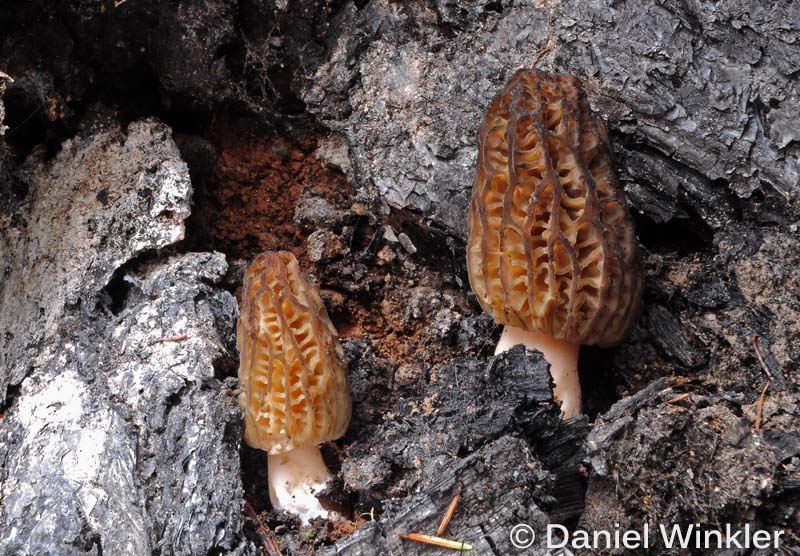
Two fire morels growing in the charred remnants of a conifer. They match the idea of Morchella anthracophila Clowez & D. Winkler with wide, ladder-like ribs and a cream-colored stage when young that will age to a pinkish brown. Some collectors like to call these fire morels "pinks". Table Mountain 4900 ft, 6-22-2013.
Note: Genetics reveal these to be identical with Morchella exima.....
However, here the original description by Phillipe Clowez (to check for yourself, if Latin or French make sense to you).
Scan from: Phillipe Clowez 2012. Les morilles, une nouvelle approche mondiale du genre Morchella.
Bull Soc Mycol Fr 126:199–376 (Photos below by Hugh & Sandy Smith & R. Chesnaux)
|
|
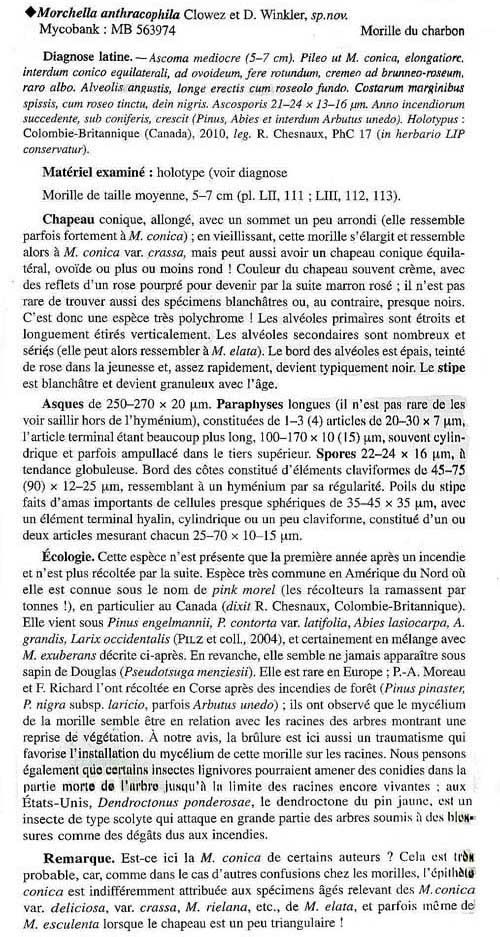 |
....back to the fire morels on Table Mountain
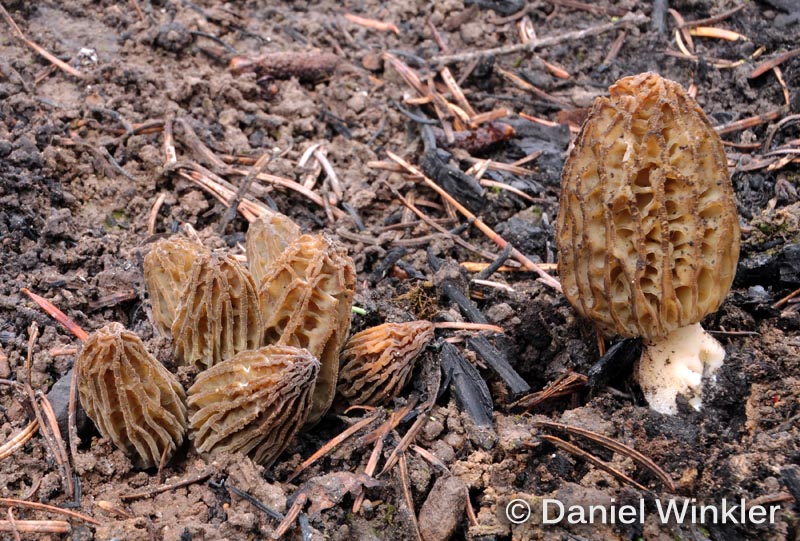
Light colored when young with hint of green in the pits. Which fire morel do we have here? Morchella eximia or M. septemelata? Blewett Pass, WA, 3500 ft, 5-18-2013.
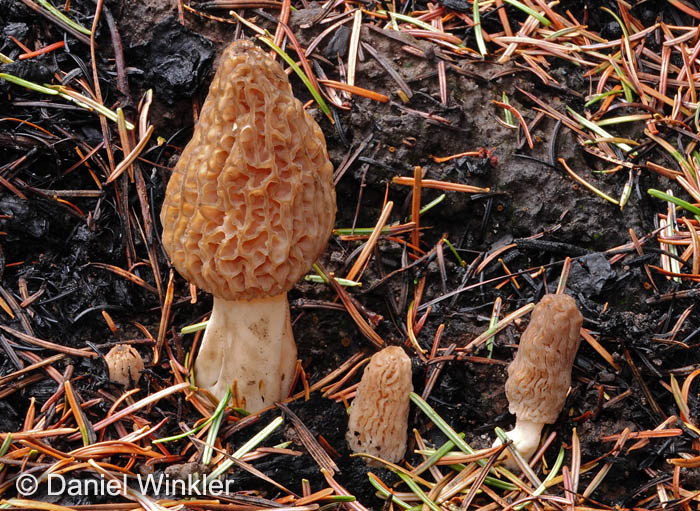
What a blond black morel! Yes, I know blonds are not blacks, but this very pale morel has evidently the shape of a morel belonging to the Morchella elata clade ("blacks"), but the light color of M. esculenta clade ("blonds" or "yellow" morels). These are the two main groups of morels. Out in the Pacific Northwest we have a Mountain blond (Pilz et al. 2007) that matches the light colored of these morels, but it is not supposed to be a fire morel. How I wished we knew our morel species.... Blewett Pass WA, 3400ft, 5-13-2013
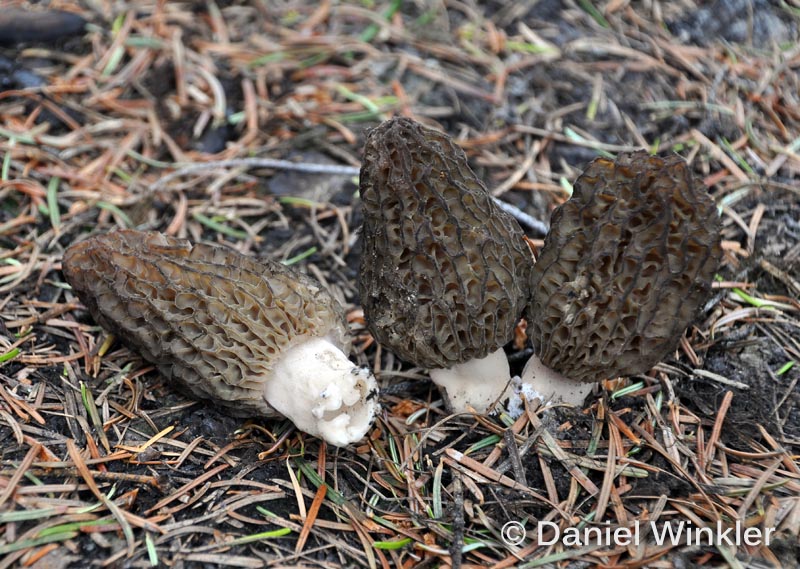
Structurally quite similar is this fire morel although its coloration is very different. Actually most fire morels seen around Table Mountain were darkish and not blond.
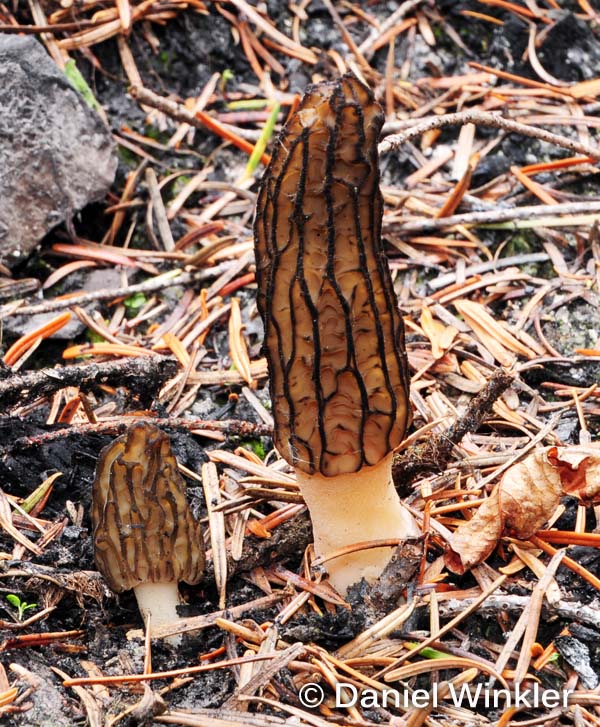
And another fire morel...... This morel is very thin fleshed and often the stem is nearly as wide as the cap, the not so well developed vallecula (= Latin "little valley"), the transition from hollow stem to hollow cap, is perfect for stuffing (see below the morels still with stem). This morel seems to turn bad much quicker than other fire morels. Also some of them grow collapsed.
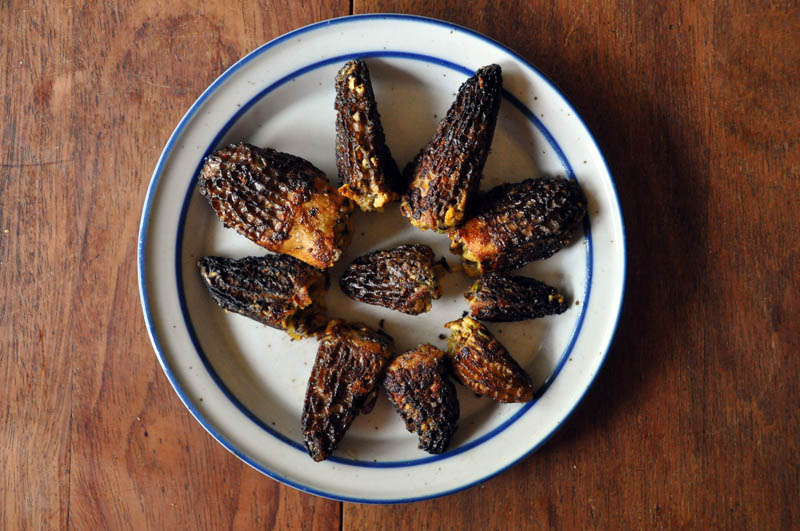
Fire morels stuffed with saffron curry rice enriched with fried morel chunks, garlic, parsley and egg. The saffron rice was spiced with the lemon, garlic & curry marinade from a Lebanese curry chicken dish. Very delicious! The fire morel season is still going and it seems like we have sufficient rain to keep it going for some more weeks here in Washington state.
"Naturals" - non fire-dependent conifer-associated morels of the Pacific Northwest
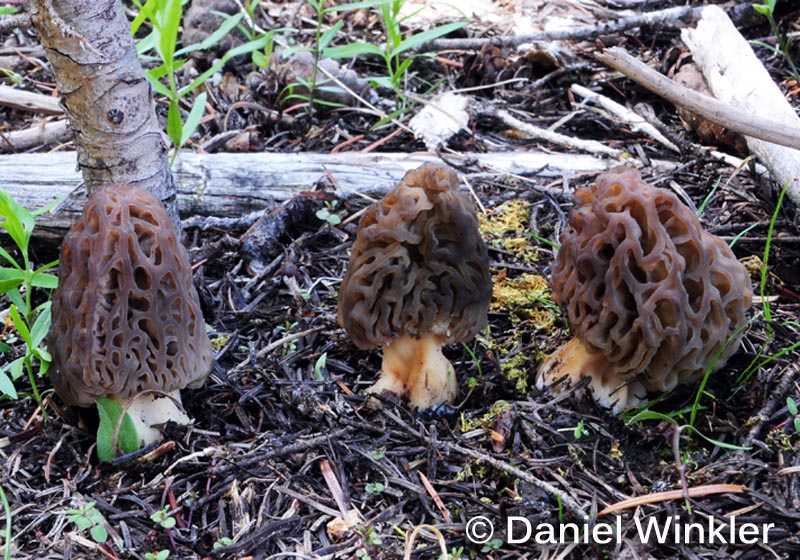
Morchella snyderi (M. Kuo & Methven), our so called "naturals", since they fruit with out fire impact under Doug fir, Ponderosa pine and true firs (Abies concolor and A. grandis). They belong to the M.elata (black morel) clade. Typical is the convoluted or lacunose stem, which is also thick walled. Very tasty morels that do not depend on fire priming
here some more of Snyder's morels
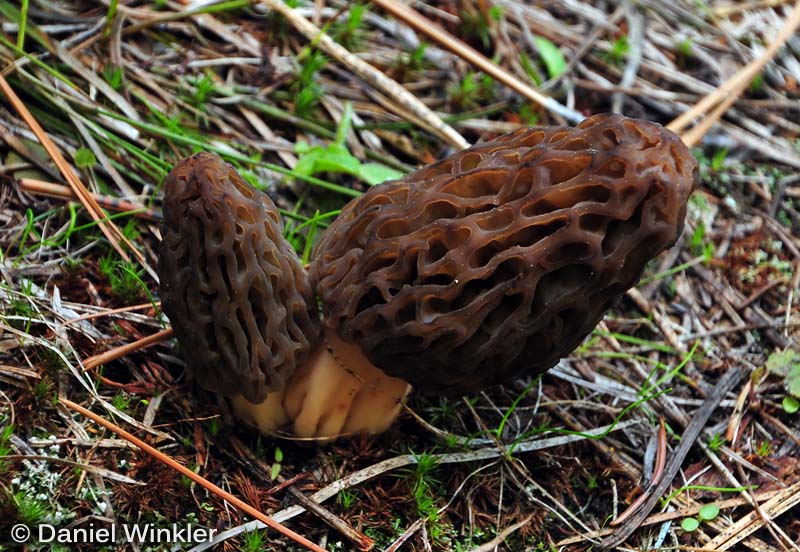
Morchella snyderi
The Morel buyers near the collection area.
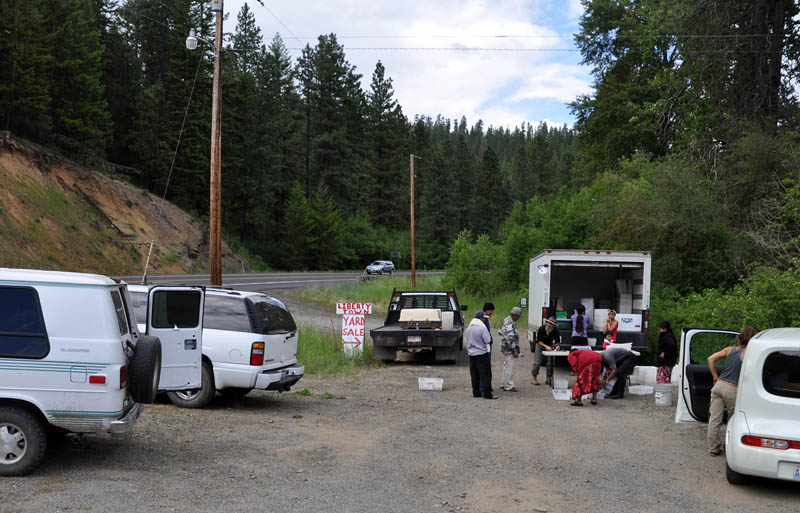
A mobile buyer on HW 97 just outside of Liberty. After the day's hunt collectors bring their bounty to the buyer. In May a pound (454g) of fresh morels was bought for 8$, in late June prices were up to 12 or 13$ per pound (Note: it takes about 9 to 10 pounds of fresh morels to end up with one pound dried). Larry Evans, a morel expert, told me he has not seen an increase of price like that in one season in his 30 years plus years in the morel circuit. Maybe demand within the US is finally picking up. In the past European importers' demand was driving the price. And interestingly a pound of dried morels fetches about the same price in the Western US and in the Tibetan areas.
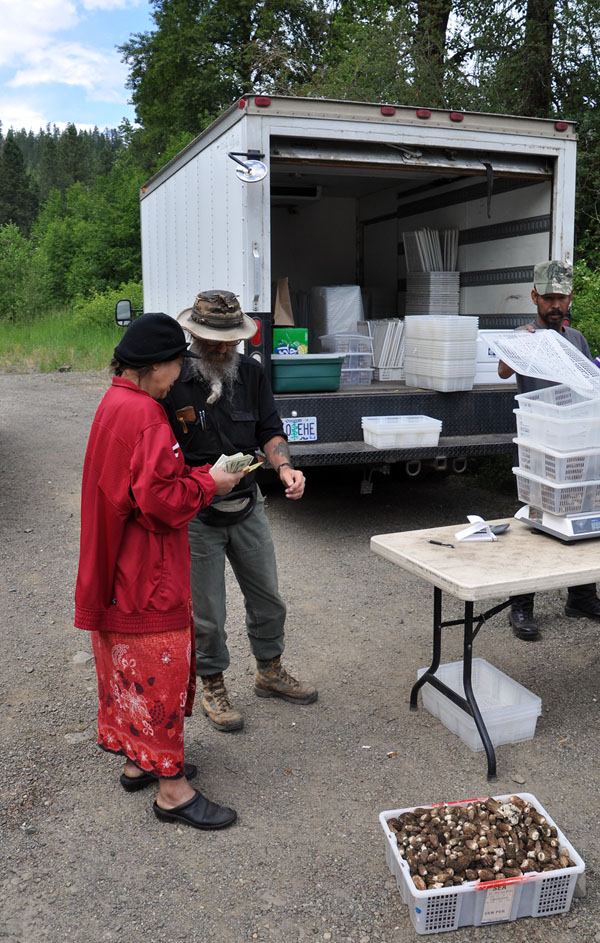 |
10 pounds of morels netted this lady 120$. She is proudly showing her money. 10pds are a lot of morels. I am sure it took this lady at least 6 to 8 hours of searching.
|
10 pounds netted this lady 120$, she showed us proudly. 10pds are a lot of morels I am sure it took this lady at least 6 to 8 hours of searching.
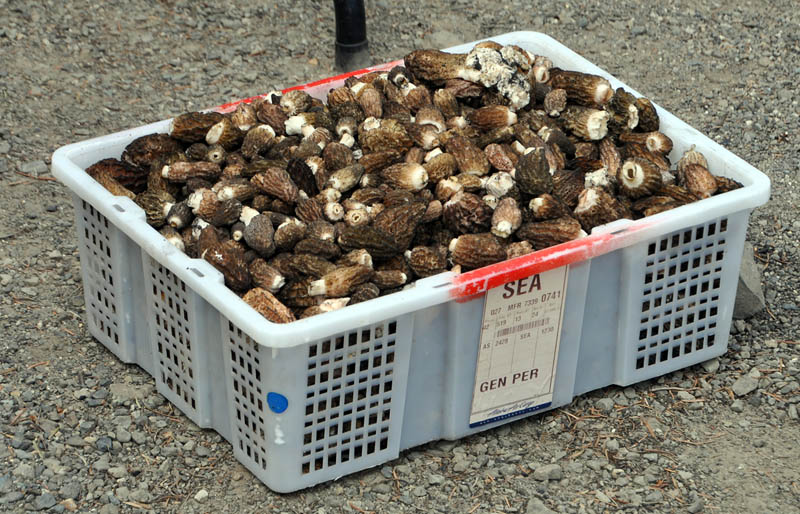
Nice!!!
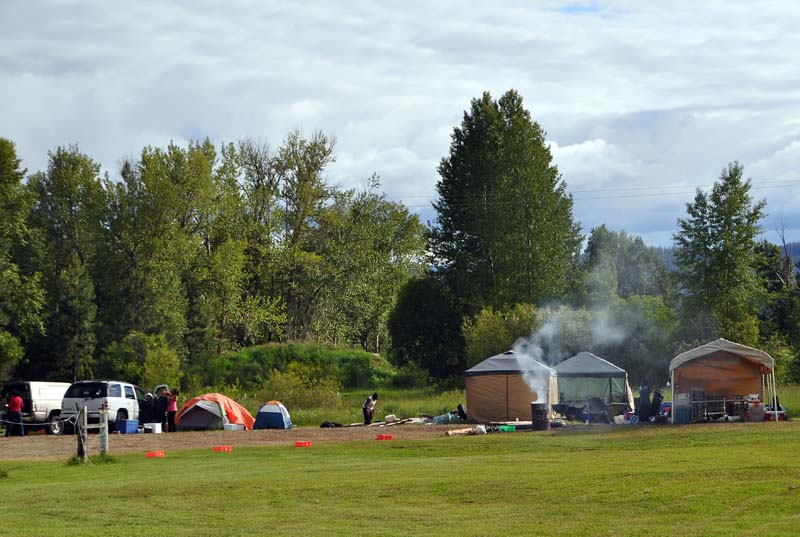
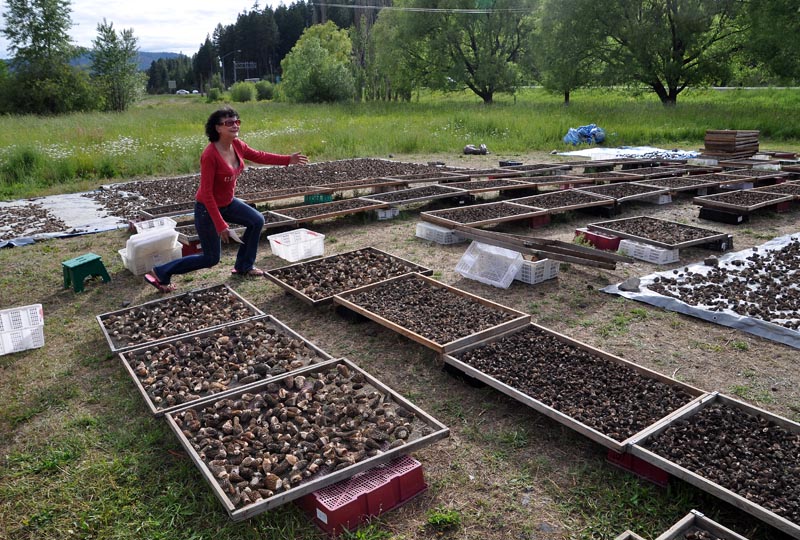
Linda Wyatt poses with all their freshly bought morels that are drying in the sun. I was told these buyers had already bought 2000 to 3000 pound, dried that is, which would mean nearly 20 to 30,000 pounds fresh. That's a lot of morels!
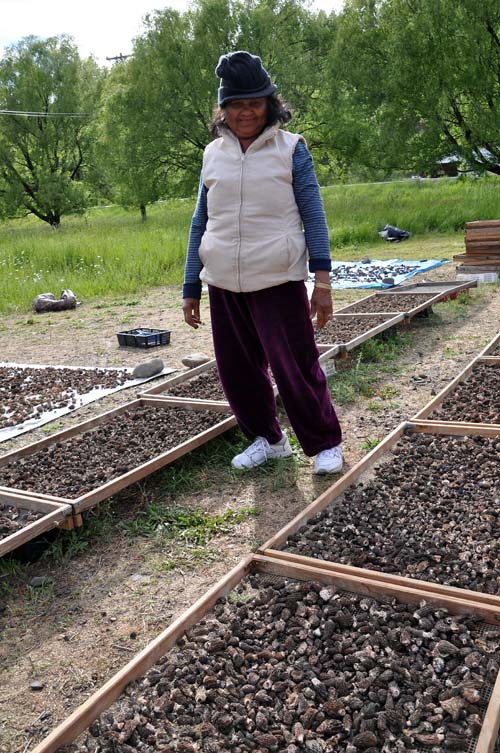
"Grandma" Mien Mond started the morel buying business Linda had told us. Near the junction of HW97 and HW 970 between Cle Ellum and Blewett Pass, WA.
Link to an article on the commercial morel collection on Table Mountain published on 11 Jul 2013 in the Northern Kittitas County Tribune written by Jim Fossett
Mushroom Harvesting-Table Mountain morels attract swarms of pickers
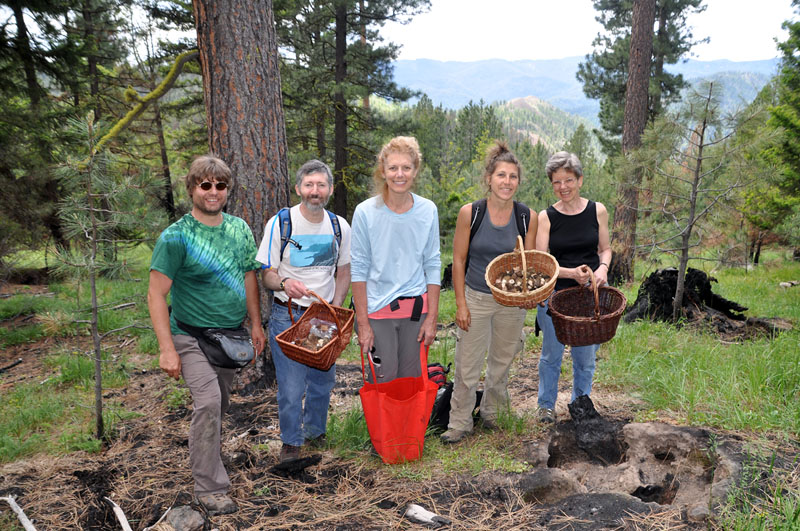
Daniel, David, Christa, Heidi and Betty happily morel hunting!
Beauty beyond the Morel
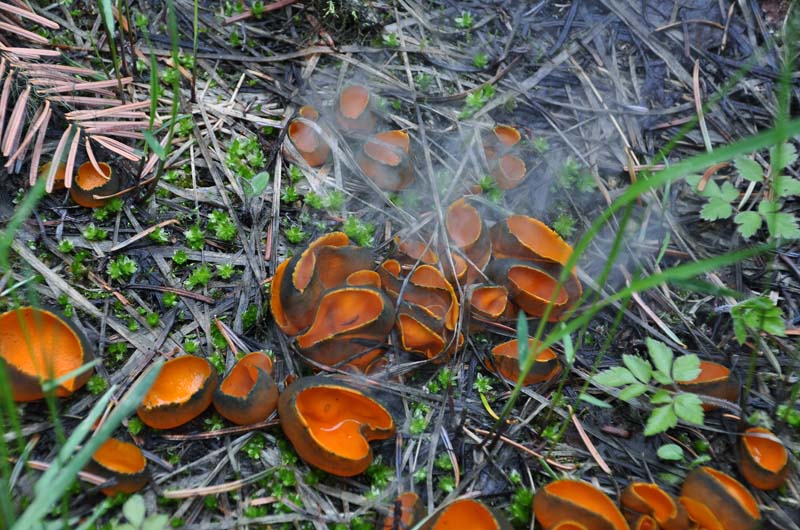
Caloscypha fulgens, a typical spring cup fungus that fruits a few weeks after snow melts, when the morels start to show. This group of Caloscypha fulgens is releasing a cloud of spores. It is easy to trigger spore release by blowing on it and waiting for a second or two. Several ascomycetes eject their spores when a gust of wind comes by.
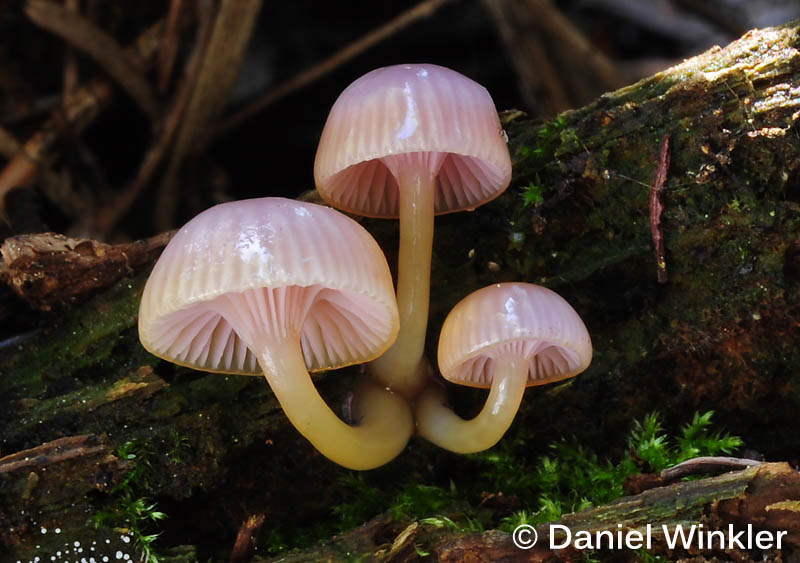
While hunting morels I came across these beauties, Chromosera cyanophylla, growing on dead wood. They used to be classified with Mycena in the past.
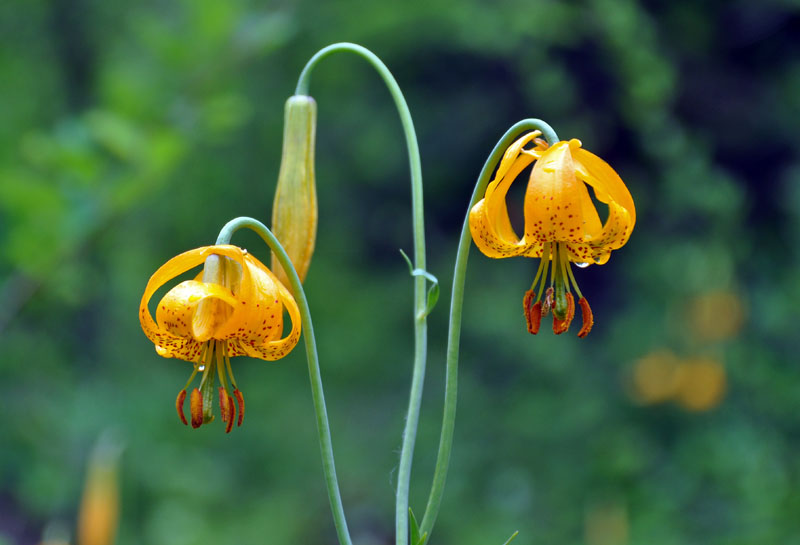
A Tiger lily (Lilium columbianum) and Western Honey suckle (Lonicera ciliosa, below), both PNW beauties seen on the way to morel hunting in the Eastern Cascades.
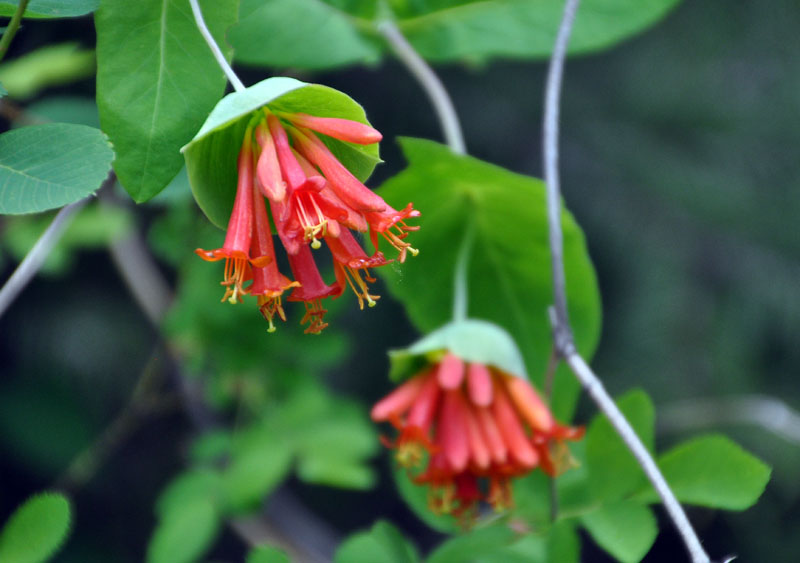
Morel processing at home
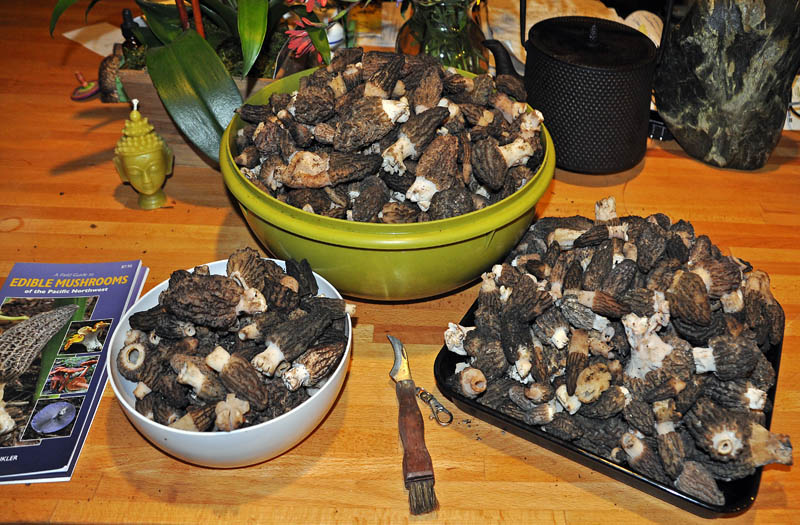
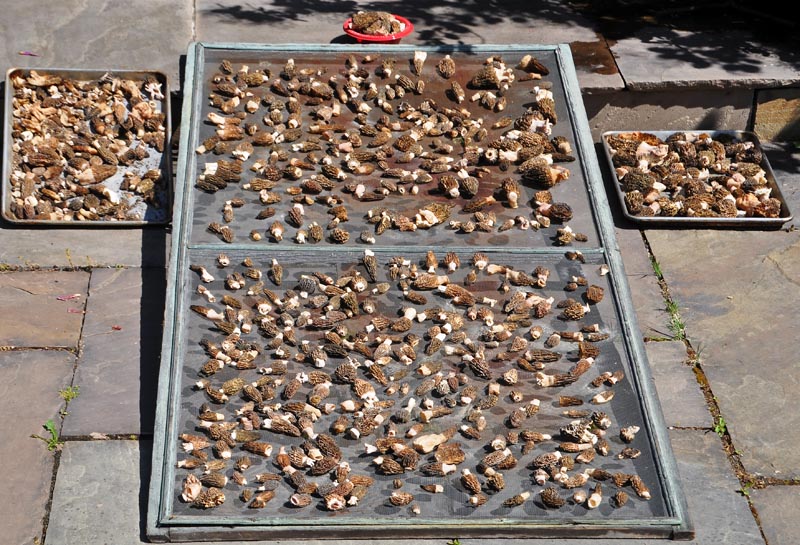
Most of our collection drying in the sun. Sun drying will enrich the mushroom with substantial amounts of Vitamin D that is contained for years to come in the mushrooms.
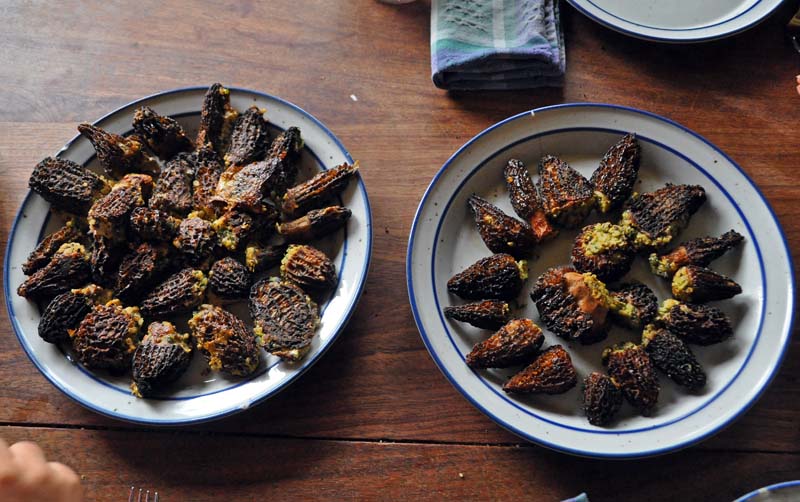
And another morel stuffing meal. This time we stuffed the big morels with two different fillings. On the left it was made of fried morels & onions, egg, quinoa and sage, on the left also fried morels & onions & quinoa, but this time we used ricotta cheese and thyme. The ricotta-thyme theme turned our to be better in the end.
Literature:
Bunyard, Britt 2013. Morels - The Name Game. Fungi 6 (1):26-32.
Clowez P. 2012. Les morilles, une nouvelle approche mondiale du genre Morchella. Bull Soc Mycol Fr 126:199–376.
Fossett, Jim 2013. Mushroom Harvesting-Table Mountain morels attract swarms of pickers. 11 Jul 2013 in the Northern Kittitas County Tribune.
Kuo M, Dewsbury DR, O'Donnell K, Carter MC, Rehner SA, Moore JD, Moncalvo JM, Canfield SA, Stephenson SL, Methven AS, Volk TJ. Taxonomic revision of true morels (Morchella) in Canada and the United States. Mycologia. 2012 Sep-Oct;104(5):1159-77.
First published July, 1st 2013
Last review Dec 23rd, 2017

